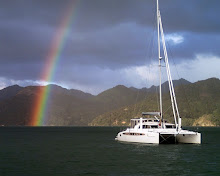We are currently anchored in the small harbor of Atuona on the beautiful
island of Hiva Oa in the Marquesas Islands of French Polynesia, former home
and burial place of French artist Paul Gaugin.
As expected, the scenery around us is breathtaking. Geologically, these
volcanic islands are still young and therefore, steep and rugged with
dramatic, jungle-covered ridge lines. Everywhere we look reminds us of
scenes from the movies King Kong and Jurassic Park. We made landfall on
the morning of April 24th and, during the 24 hour period prior to our
arrival, continually made adjustments to our sailing speed so as to arrive
shortly after sunrise. We did however, get our first glimpses of the
dark silhouette of the island at around 2am and, a short time later, began
to smell the rich, earthy aroma of the island’s fertile soil, a smell much
like that of damp peat moss.
After anchoring among boats displaying flags from mostly European
countries, we took short naps and then dove into the daunting task of
cleaning “Blue Rodeo” inside and out. What a pleasure it was to be
settled in a protected anchorage and not having to endure the constant,
irregular motion that we had experienced for much of our crossing from
Mexico. That day, friends on the vessels “Charisma” and “Island Bound”
also completed their passages and joined us in the harbor. We hosted a
celebratory dinner aboard that night with a delicious main course of fresh
Dorado and Wahoo courtesy of our friends from both boats. We all turned
in early that night and slept longer than we had in several weeks. The
next morning, we were accompanied into town by an agent who assisted us in
officially clearing into the country at the office of the town’s gendarme.
The process was very straight forward and, before long, we were exploring
the rest of the small town in search of some fresh fruits and vegetables
and regular internet access. The town consists of just a few grocery
markets, a general store, post office and one restaurant. Our walk about
concluded with a simple lunch at that restaurant. Their menu ranged from
burgers to chicken curry to the local specialty, poisson cru which is raw
fish marinated in citrus juice and coconut milk. Having spent most of
the last two years in Mexico attempting to learn and converse in Spanish,
we are now finding it especially difficult to shift gears and retrieve
what little French we know from the dusty corners of our brains. We
imagine though that, with the help of the friendly locals, we will be
doing much better in the months ahead. The day concluded with an early
evening get together aboard the large and spacious catamaran “Orcinius,”
hosted by new friends John and Lisa.
Our plans are to spend two more nights here sightseeing, going to a pig
roast and doing a few boat chores before moving on to explore other more
remote anchorages.
We are happy that the long passage here is behind us and thrilled to be in
this amazingly beautiful, tropical land. The weeks ahead will be spent
traveling through the other islands of the Marquesas and getting a glimpse
into what remains of authentic Polynesian culture.
Briefly, here is a recap of our trip from La Cruz, Mexico. We covered the
first 350 miles to Isla San Benedicto in about 66 hours, sailing mostly
hard on the wind with occasional periods of light air but average breezes
in the 15 to 18 knot range. We used our diesel engine for the first hour
leaving Bandaras Bay and again for about 1.5 hours when the wind died
approaching San Benedicto. After 5 wonderful days there, we set sail for
Hiva Oa, about 2,750 miles to the southwest. That leg took 16 days.
Aside from about 30 minutes of motoring while we raised anchor and another
45 minutes during our arrival, we sailed the whole way with good winds.
We had brief periods of wind in the high 20s to low 30 knot range but the
average speed was in the teens. Luckily, we encountered no thunderstorms
but did have a few areas of heavy rain as we transited the area around the
Equator. “Blue Rodeo” took good care of us with just a few mechanical
issues to deal with. The glow plug preheat circuit on our auxiliary motor
decided to act up a bit. A clevis pin on the bottom toggle of our
forestay nearly worked its way out after shearing off the retaining cotter
pin requiring some teamwork to re-insert and re-pin it. A snatch block
used on our mainsail preventer line exploded during the night as the
result of constant loading as the boat rolled in the irregular cross-
swells. And finally, our main sail halyard chafed through at the mast
head dropping the sail to the boom and requiring that we sail the last 500
miles with just our jib.
We are eager to see what lies around the next bend of the island so, soon
we will again raise our anchor and sails and head back out. No more 16
day passages though. By comparison, the remaining legs we sail as we
cross the South Pacific will seem like just a hop, skip and jump
Subscribe to:
Post Comments (Atom)

No comments:
Post a Comment